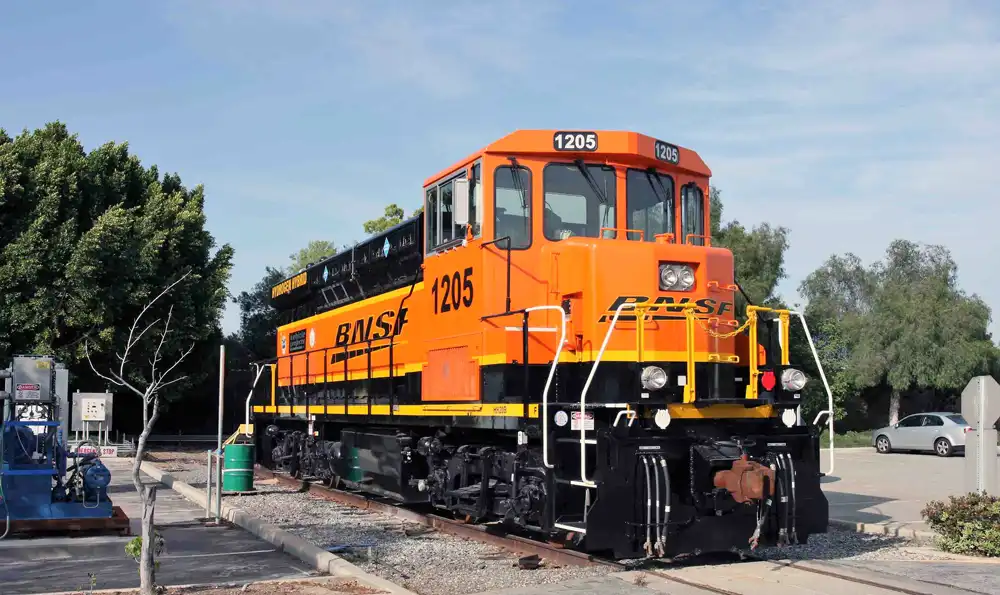The Oklahoma Railway Museum has recently acquired a locomotive that served as a hydrogen fuel cell switcher in Southern California. This historic alternative fuel testbed locomotive was generously donated by BNSF Railway.
Originally manufactured as Canadian Pacific GP9 No. 8637 in 1957, this locomotive underwent a rebuilding process by CP in the mid-1980s. It continued to be employed in routine operations until 2006, at which point it was transformed into a “Green Goat,” an early iteration of a battery-electric switcher. In the year 2007, the aforementioned unit underwent acquisition by BNSF and was subsequently reconstructed into a hydrogen fuel cell unit at BNSF’s locomotive shop plant located in Topeka, Kansas. This transformation was made possible through a collaborative effort involving Vehicle Projects Inc., Ballard Fuel Systems, and the U.S. Department of Defence, as part of a public-private collaboration.
The unit was publicly revealed on June 29, 2009, and afterwards relocated to Pueblo, Colorado, where it underwent comprehensive testing at the Transportation Technology Centre administered by AAR. Following successful testing, the unit was deployed for operational use at BNSF’s Hobart Yard in Los Angeles. This information can be found in the article titled “BNSF’s first hydrogen locomotive” on Trains.com, published on July 16, 2023. In 2014, following a period of operation and data collecting at Hobart Yard, the unit was decommissioned and then donated to ORM by BNSF. The test unit served as a precursor for forthcoming advancements in alternative energy technology at BNSF. Additionally, BNSF is currently making preparations for a demonstration of a hydrogen fuel cell locomotive on its mainline in collaboration with Progress Rail and Chevron, scheduled to take place in 2024.
According to ORM Trainmaster Greg Hall, the inclusion of this distinctive BNSF locomotive in our museum collection is a source of great excitement. The BNSF 1205 locomotive is in excellent condition, and we intend to repurpose it as a push platform for use on our trains. Our intention is to narrate the narrative of BNSF’s endeavours in attaining diminished locomotive emissions by means of the advancement of technologies that have the potential to ultimately supplant the utilisation of fossil fuels. We really acknowledge the generosity demonstrated by BNSF.
According to Jeanelle Davis, the executive director of public affairs for BNSF Railway, the utilisation and advancement of the BNSF 1205 serves as a singular illustration of the continuous endeavours undertaken by the company to facilitate the transportation of goods across the nation while concurrently mitigating its environmental impact. This is particularly noteworthy considering that BNSF Railway is already recognised as the most ecologically sustainable form of terrestrial transportation. The inclusion of this locomotive has yielded significant contributions and laid the foundation for the advancement of alternative fuel technologies within the railway industry. We express our satisfaction in successfully securing a placement for the BNSF 1205 locomotive at the esteemed Oklahoma Railroad Museum. The ORM serves as an exemplary community collaborator, and we highly appreciate the mutually beneficial association between the museum and BNSF.
ORM, which was established in 1997, currently manages a significant stretch of the former Missouri-Kansas-Texas Railroad mainline in close proximity to the central area of Oklahoma City. The primary objective of ORM is to provide educational experiences centred around the extensive railroad heritage of the region, which dates back to the 1880s. This is achieved through several means, including train rides, the exhibition of old equipment and artefacts, the organisation of special activities such as Polar Express trains, the provision of interpretive displays, and the hosting of community events. The inclusion of testbed equipment, like the BNSF 1205, alongside vintage rolling stock and locomotives, provides visitors with an opportunity to witness the progression of railroading throughout history and the ongoing advancements in technology within our country’s railway systems.
